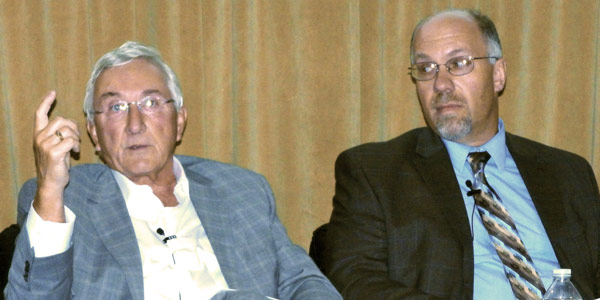By Christen Smith
American Municipal Power said Wednesday that PJM’s rush to file its energy price formation proposal with FERC leaves the door open for design flaws.
AMP CEO Marc Gerken sent a letter to the PJM Board of Managers criticizing the RTO’s “arbitrary” and “self-inflicted” deadline to implement a revised set of rules that a majority of stakeholders doesn’t support. (See PJM Advances Own Energy Price Formation Plan.)
“Broad review of all aspects of market changes is one of the primary benefits of the stakeholder process; a benefit PJM staff seems disinterested in availing itself of,” Gerken wrote. “While PJM and stakeholders are often under tight timelines, that is not the case here. There is simply no need for PJM to rush ahead with this [Federal Power Act Section] 206 process.”
Section 206
The letter comes two weeks after PJM staff hosted a meeting with stakeholders reviewing the evolving language of its proposal, which they said would be filed by March 31. Nine sections to be added to the Operating Agreement had not yet been finalized, Gerken said, while manual revisions memorializing the changes had yet to be drafted.
Filing under FPA Section 206 allows PJM to submit a proposal that doesn’t have stakeholder consensus. Stu Bresler, senior vice president of operations and markets, told stakeholders in February that staff would recommend the board submit the RTO’s proposal to FERC after multiple compromise packages failed to garner enough support. (See Last Gasp Bid on PJM Price Formation Falls Short.)
Gerken argued that PJM’s lack of preparedness suggests the stakeholder process could have carried on despite the Jan. 31 deadline for a compromise set by the board in December. (See PJM Board Demands Action on Energy Price Formation.)
“That this level of detail is still being developed should be a clear sign to the board that PJM was no more prepared than the rest of the stakeholders to act within the board’s arbitrary deadline,” he said. “Forcing a solution and an unrealistic deadline has resulted in PJM being forced to make an FPA Section 206 filing rather than a [Section] 205 that could have resulted from a reasonably managed process.”
He also criticized staff’s decision to let manuals determine key aspects of its proposal, saying “it does not strike the appropriate level of granularity that should be included in the Operating Agreement.”
“Not addressing these components of PJM’s proposal fails to give stakeholders the opportunity to understand and provide feedback on PJM’s proposed changes,” he said.
Undisclosed Changes
Gerken’s letter further chastised PJM for making changes to its proposal after the Jan. 24 meeting of the Markets and Reliability Committee. He said staff posted PowerPoint slides detailing the changes online 24 hours before the March 14 meeting, some of which he described as “significant” alterations.
PJM presented the following changes to stakeholders during the meeting, including:
- Capping demand response procurement at 50% instead of the previously recommended 33%;
- Changing how equivalent demand forced outage rates are reflected in the operating reserve demand curve (ORDC);
- Recalculating lost opportunity costs for offline resources;
- Revoking market participants’ ability to self-schedule resources as secondary or non-synchronized reserves;
- Changing real-time treatment of inflexible resources with a day-ahead reserve commitment; and
- Using the ORDC to calculate a secondary reserve nonperformance penalty.
“PJM had an obligation to inform stakeholders of such fundamental changes prior to voting at either the January MRC or the special [Members Committee meeting] that was called to vote on the consensus proposal,” Gerken said.
An Unusual Step
PJM took an unprecedented step earlier this month when it convened a meeting to discuss the Section 206 filing with stakeholders. Typically, feedback isn’t sought on 206 filings.
Dave Anders, director of stakeholder affairs, said staff decided to organize the meeting after members requested to view the proposed tariff revisions. Engaging stakeholders prior to filing with FERC is a lesson the RTO learned when implementing Capacity Performance rules, he said.
It appears the board won’t be stalling the process any further, however. Jeff Shields, a PJM spokesman, told RTO Insider on Thursday that staff will file the plan Friday afternoon.
“It will be a timely and comprehensive proposal addressing well-documented, much-needed reforms to the way reserves that ensure reliability and flexibility are priced and compensated in our markets,” Shields said.



